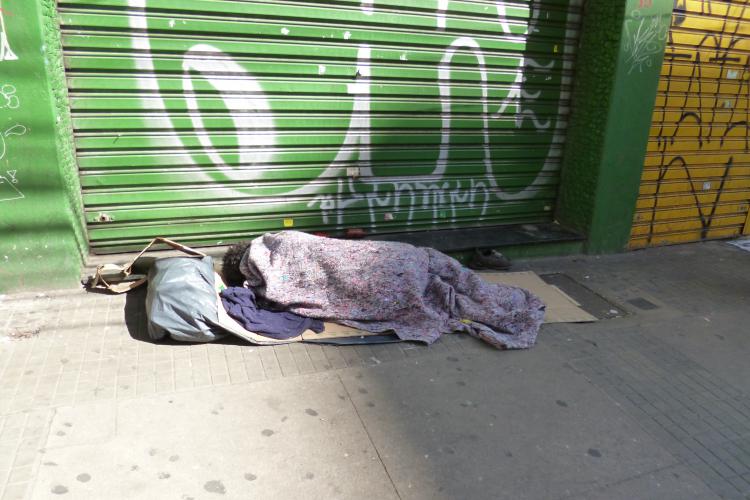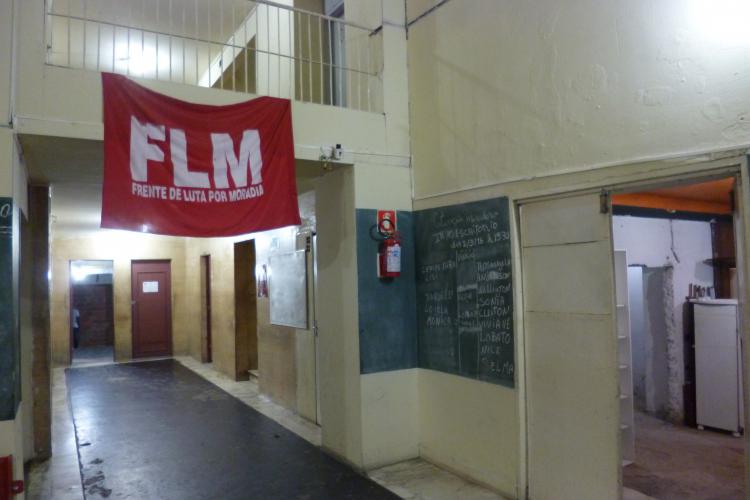Porous Walls: Fragmented Protection in the Face of Migrants’ Displacement in Brazil
Posted:
Time to read:
Guest post by Heike Drotbohm, Social Anthropologist and Heisenberg Fellow at University of Freiburg, Germany.
Mobile populations face many barriers once they arrive at a new place. Shelter, the spatial dimension of ‘refuge’, lies at the roots of the concept of asylum. As a social right it owes much to the notion of hospitality and is closely connected to the human dignity of every person, regardless of his or her residency status. However, finding a safe place remains a key challenge for most refugees and other migrants, especially in the first phase after their arrival, when they lack the respective financial means, local contacts, and eventually the language for articulating even their most basic needs.

Anthropological research was carried out in the sprawling Brazilian megalopolis of São Paulo, the Western Hemisphere’s biggest city, where more than twelve million people struggle for their ‘right to the city.’ Currently, large segments of the Brazilian population don’t have access to affordable housing, living in peripheral areas, in favelas, or derelict downtown neighbourhoods.
‘It’s not so difficult to get to Brazil. They were the only ones to give us visa. It’s a safe journey, you can simply take the plane, as long as you can buy the ticket. But then. How to continue—nobody will be able to tell you. There are too many people, they are everywhere. You might be lucky to know someone, but they will usually only be able to host you for some days. After a while you’ll be back on the street. And these are dangerous streets in this country, man.’ (Man from Iraq, 43 years old, travelling on his own)
In Brazil, as in the majority of other Latin-American countries, migrants’ realities are shaped by a peculiar paradox. On the one hand, public discourse entails an exceptionally progressive attitude towards migration and migrants’ rights. Particularly in the contemporary so-called migration crisis, Brazil has accepted far more refugees than any other country in Latin America. On the other hand, the execution of migration policies often remains contradictory and arbitrary. Foreigners who are able to receive a visa and gain territorial access, will learn early that the cities are especially overpopulated, bureaucratically complicated, and very expensive.

Humanitarian organizations such as the ‘Centro de Referência para Refugiados’, organized by Caritas Arquidiocese de São Paulo, or the Missão Scalabriniana Nossa Senhora da Paz, known as ‘Missão Paz' (see image 2), therefore offer important services, such as legal assistance, psychological counselling, contact with potential employers, and language courses. Providing adequate shelter, however, remains a key challenge for these social institutions.
‘When you sit here and wait, you listen to how the others compare the different places Caritas can send you to. Some places are good, at some places you will be able to stay for some time, sometimes even up to a year! You don’t have to pay, you can stay until you’re settled. Others will host you only for some weeks. And then you risk being back on the street. And then there are some places, they are said to be truly horrible. You should definitely not go there, even if they send you there.’ (Woman from Angola, 38 year old, travelling with two small children).
This Angolan woman tackles a problem that arose from the continuously rising numbers of refugees and migrants that came to São Paulo since the summer of 2015 and the simple fact that space in public shelters is limited. Today, many different kinds of organizations provide accommodation, but each works for a different type of clientele, addressing particular sorts of ‘profiles’ of neediness.

The prefecture of São Paulo, for instance, offers approximately 10,000 sleeping places for people em situação de rua. Migrants and refugees have access to these places if they address one of the centros which distribute vagas—available positions—on a daily basis. Image 3 shows a tenda (tent, the unofficial term for this type of daily accommodation], one of those public spaces to which anybody in need for a safe place for the night can turn to. However, when migrants sit and wait for their vaga together with street dwellers and crack users, they feel lumped together and confronted with particular types of vulnerability and urban exclusion that they don’t identify with. This particular tenda, which is located under a bridge, has no walls, but is enclosed by a fence, thus offering something in between the open, unprotected street and a closed living space.
‘After I left my friend’s house, I tried other places, but they did not work out. I ended up sleeping in the street. After two nights I felt like an insect

Migrants are the majority of the homeless in São Paulo according to a recent census published by the Secretaria de Assistência e Desenvolvimento Social (SMADS) of the prefecture of Sao Paulo in April 2016. However, in this document, the term migrante also refers to internal migrants; that is, to Brazilians who came to São Paulo from other regions.

Other public shelters, which accommodate both Brazilians and non-Brazilians who are in need of a place to stay, are organized along a strict daily routine. The Arsenal da Esperança (see image 5), which is run by a small Italian brotherhood linked to the Catholic church, hosts more than 1,000 men—and only men—every night. Being installed in the ancient guest house for immigrants, which was opened in 1887 for hosting newcomers from foreign countries as well as from the Brazilian northeast, it continues to be oriented towards the profile of the classical migrant worker: male, independent, able to circulate in the city and search for work on a daily basis.
‘I got here with several friends I met along the road to Brazil. Here I can stay as long as I search for a job. Some stay long, some even more than a year. Brazilians and migrants. But we only stay for the night. We have to get up early, have breakfast and leave the place around seven in the morning. During the day we don’t have access. We stay somewhere in the city and get back for dinner, around six.

‘When they brought us here, I was really shocked. We’re getting sick. The noise. Cars going above us and below us, this sound, the smell, there are rats, cockroaches, you can’t use the toilet. It’s a disaster.’ (Woman from the Republic of Congo, 45 years old, travelling with three children)
Employees at the city council tried to calm the situation. ‘We don’t know why we receive these numbers from Africa, all over a sudden. They are too many, and only women, pregnant women! It’s an emergency situation, we do what we can. It won’t take much time to find something better.’ While the women were staying under—or, perhaps more accurately, inside of— this bridge, they were addressed not only by some homeless people, who claimed this space, but also by evangelists, members of political activists, and NGOs that tried to offer counseling.
‘I am so tired of all these “angels.” They come and talk, but in the end they have nothing real to offer. We just need a place where we can stay, where we have our own space, where we don’t have to share everything with everybody. Here, everything is open. You don’t have any privacy. I have never slept together with so many people in one room. I miss the silence.’ (Woman from Angola, 23 years old, travelling with her son)

Finding a private apartment usually takes a long time, as these are extremely expensive in São Paulo and often require the guarantee of a person who’s a citizen and also owns property. The city faces a housing shortage and some 1.2 million Paulistanos live either in favelas or in downtown squats called cortiços (illicitly occupied and abandoned buildings). In recent years, São Paulo is at the heart of such building occupations, ranging from strictly organized social movements that occupy and run these buildings to improvised squats by smaller groups. Although these movements often carry the sem-teto (without roof) in their names, many are organized by political activists, who fight not only for decent housing and the revitalization of the city center, but also against poverty and for women’s rights, global equality, and so on.

The integration of foreigners into these occupied buildings and into the respective social movements is a very recent phenomenon. In order to get access, they have to follow the rules. They have to: address the head of the organizing commission, present themselves during a collective meeting during which the movement’s aims and conditions will be explained, and respect the instructions of daily living and activism.
‘A person who wants to live in this building, Brazilian or foreigner, has to become part of “the struggle”

‘We’re all having the same interests. Migrant, refugee, citizen, this is not important anymore. Some came here from favelas, some from the northeast, they also didn’t know how to get along in this city. We fight for the same objectives. We’re all the same, just poor displaced people.’ (Man from Haiti, around 40 years old, living in one occupation together with his wife and three children)
Other migrants feel stressed by the obligation to integrate themselves into the activists’ continuous struggle and fear that the building one day might be ‘reintegrated’ (i.e., reclaimed by its owner after the legal dispute is solved).

‘Somebody told me, you go there, and then you stay. You don’t have to move again. I go here, together with my child. I present myself in front of some kind of commission. They told me all the rules. And then I was able to stay. I got a room on my own. They made me whole again. But then, we are not used to live in such as space, together with so many people. They want you to do this and that, there are many rules. And then: a demonstration here, some other event there. You can never relax. And the walls are very thin, just wood. You hear everything. Since I left my country I was never on my own again.’ (Woman from Nigeria, 32 years old, living in one occupied building with her small daughter)
Concluding remarks
Mobile populations who search for shelter become part of new paradigm of differentiation, one that is highly influenced by the ways in which institutions think, classify, and bring their particular types of routines into the social world of 'neediness'. In the course of their urban trajectory, migrants learn that citizenship is not the only nor key dividing marker of belonging, but that notions of gender, age, and kinship sometimes can contribute to the fragmentation of support. Experiences of displacement produce new types of political subjectivities, perceptions of rights, and solidarity, but also new sorts of temporalities and spatialities, when both—being and remaining—on one’s own becomes a new challenge.
Any comments about this post? Get in touch with us! Send us an email, or post a comment here or on Facebook. You can also tweet us.
__________
How to cite this blog post (Harvard style):
Drotbohm, H. (2016) Porous Walls: Fragmented Protection in the Face of Migrants’ Displacement in Brazil. Available at: https://www.law.ox.ac.uk/research-subject-groups/centre-criminology/centreborder-criminologies/blog/2016/05/porous-wall (Accessed [date]).
Share:








